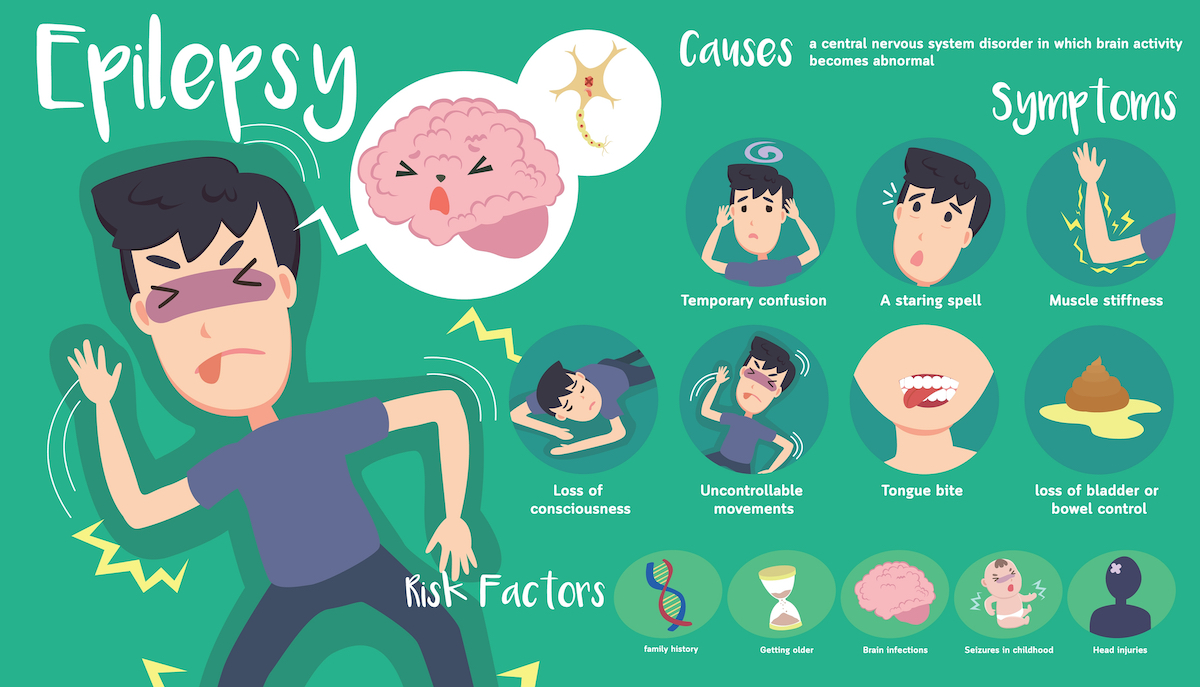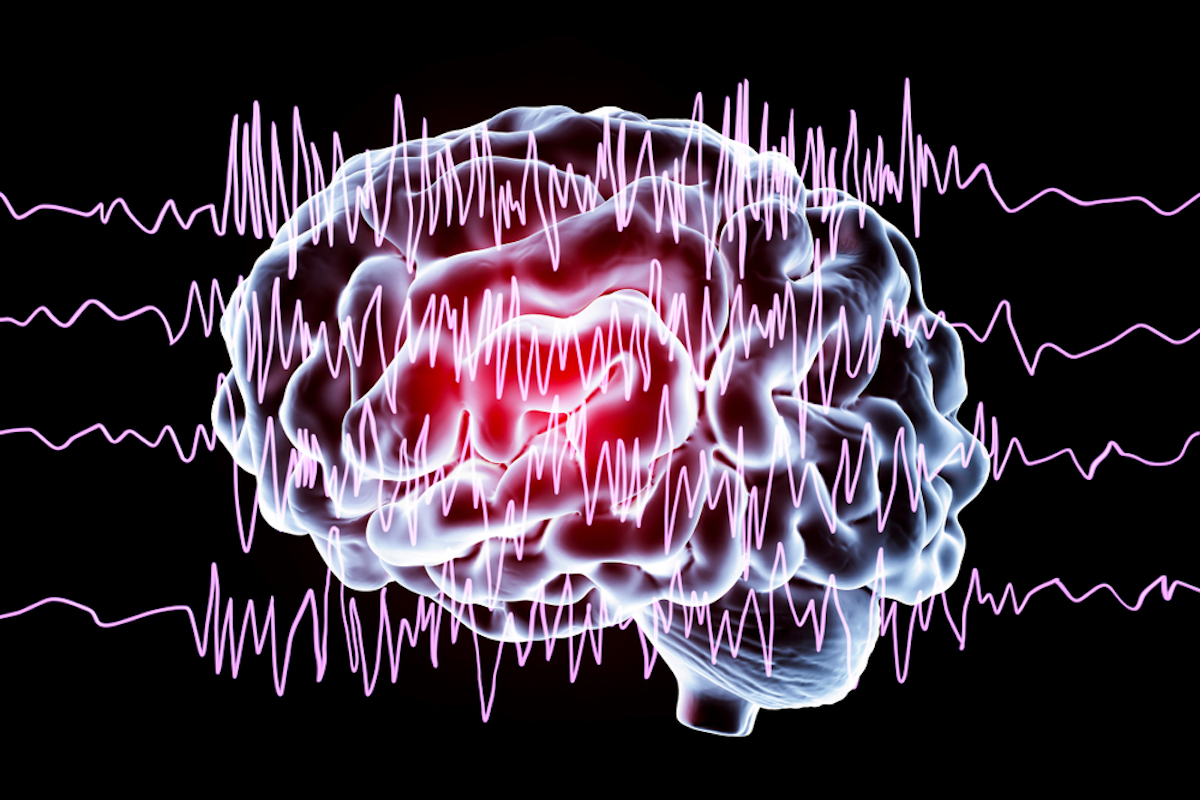Epilepsy – also called seizure disorder – is a neurological disorder in which brain activity becomes abnormal, causing seizures or periods of unusual behavior, sensations, and in some cases loss of awareness. In epilepsy, abnormal brain activity means that nerve cells don’t signal properly, which causes seizures. About 65 million people worldwide are suffering from this central nervous system disorder.

In the United States, about 3.4 million have epilepsy and each year there are about 150,000 new cases. Everyone – doesn’t matter the age, ethnicity, or gender – can develop epilepsy. Making it a fairly common condition that affects 1 in 26 Americans. Being educated about this disorder is very important. For example: what causes epilepsy, how do you recognize it, and is there a cure?
Causes of Epilepsy
What exactly causes (active) epilepsy is in most cases unknown. In about 30% of epilepsy cases, there is a known cause. These include:
- Hereditary
- Mesial temporal sclerosis; a scar in the frontal lobe that may cause seizures
- Head injuries, accidents; falls or blows to the head
- Brain infection; like brain abscess, meningitis, encephalitis
- Immune disorders, the immune system attacking brain calls, causing seizures
- Developmental disorders, like focal cortical dysplasia, polymicrogyria, and tuberous sclerosis
- Metabolic disorders
- Brain conditions, like brain tumors, strokes, and dementia
- Brain vessel abnormalities, like arteriovenous malformations.
Types of Epilepsy Seizures
There are no different types of epilepsy. All patients have the same diagnosis called epilepsy. What does differ – and is thus categorized differently – is the type of seizures a person has. These types are based on where the seizure starts in your brain, your level of awareness, and if there is any presence of muscle movement during a seizure. The two seizure groups are called: focal onset seizures and generalized onset seizures. Focal onset seizures start in one specific part of the brain, whereas in generalized onset seizures, a larger network of brain cells on both sides of the brain is affected. These major types are divided into subtypes. These include:
- Focal onset aware seizure, means someone is awake and aware during the attack.
- Focal onset impaired awareness seizure, means someone is confused or lost consciousness during the attack.
- Absence seizures, someone had a brief loss of awareness during an attack.
- Atonic seizures, someone lost muscle control or has weak muscles during an attack.
- Tonic seizures, someone has tense/stiff muscles during an attack.
- Clonic seizures, someone has repeating stiffening and relaxing muscles during an attack.
- Tonic-clonic seizures, someone has a combination of the above two-mentioned types.
- Myoclonic seizures, someone has short shock-like muscle twitches during an attack.
Sometimes seizures can come out of nowhere, but medical research has shown us that several things can cause someone to get into an epileptic seizure. Possible triggers are stress, sleep problems – like bad patterns, being overtired and disrupted sleep, use of addictive substances, like alcohol & drugs, hormonal changes, flashing lights or patterns, dehydration, and not eating healthy and specific foods, like caffeine. Of course not taking prescribed medication to prevent you from getting seizures, also triggers epileptic seizures.

Symptoms of Epileptic Seizures
The biggest symptom of epilepsy is recurring seizures – or in other words, experiencing one seizure does not say you have epilepsy. When the seizures are a recurring thing, it is diagnosed as epilepsy. Fortunately, this isn’t the only warning sign, others include:
- Loss of consciousness
- Uncontrolled muscle movements, like jerking or loss of muscle tone
- Blank stare, like someone is “staring into space”.
- Temporary confusion
- Slowed thinking
- Problems with talking or understanding
- Changes in the senses
- Mood changes
- Feeling of numbness or tingling
- Upset stomach
- Waves of heat and cold & goosebumps
- Lip-smacking or chewing motion
- Rubbing hands or finger motions
- Fear, anxiety or déjà vu
- Increased heart rate and/or breathing
This of course varies per type of seizure someone is suffering from. With focal onset aware seizure, someone is completely aware of what is going on and the symptoms associated with it are changes in the senses, mood changes, uncontrolled muscle jerking in the arms or legs, seeing flashing lights, and feeling dizzy and numb. Absence seizures are the type of seizure where someone stares “into space” and loses awareness for a brief period. When a person has epilepsy, that person almost always gets the same type of seizure. This means that they often experience the same symptoms and thus can recognize them.
Get Diagnosed
When someone experiences two or more seizures not caused by a known medical reason – such as low blood sugar – you can say he or she has epilepsy. Of course, you cannot make this diagnosis yourself; for that, a person needs to go to a professional healthcare provider. Your healthcare provider will refer you to a specialist or perform tests to make the correct diagnosis. This is necessary to create the right treatment plan. In addition to a physical & blood test and interviews with you and witnesses who have seen your “possible” epileptic seizures, an EEG and a brain scan will also be done. After this, it can be determined whether a person has epilepsy.

Treatment Options for Epilepsy
Once epilepsy is diagnosed, there is good news and bad news. The bad news: there is no cure for this neurological disorder. The good news: there are now well-established ways to treat/prevent seizures and other symptoms. These treatment options include anti-seizure medications, special diets, and sometimes surgery. The anti-seizure medication works for about 60% a 70% of the cases. There are different types of medications, so while determining your treatment plan, we will consider what seizure type you have, your age, your general health, and the cost of a particular medication.
The first medication may not always work for you, so you may have to switch to another anti-seizure medication. If anti-seizure medicines don’t work, your healthcare provider will recommend surgery – especially if you’ve severe and exhausting epileptic seizures. Surgical options include:
- Surgical resection; removal of abnormal tissue in the brain.
- Disconnection; cutting fibers that connect areas of the brain.
- Stereotactic radiosurgery; targeted removal of abnormal tissue in the brain.
- Implantation of neuromodulation devices; a device that signals to the brain to reduce/prevent seizures.
Not treating epilepsy can cause serious complications. In some cases, people die, which is called sudden unexplained death in epilepsy (SUDEP). Thus, it’s good to educate yourself on what treatment options are out there and which one suits you well. We help you on your way, start your online search here:

